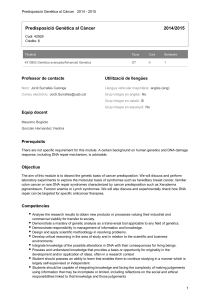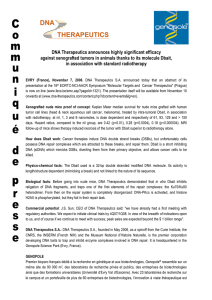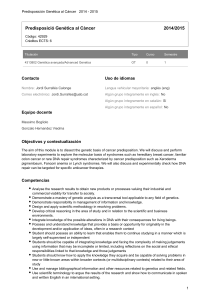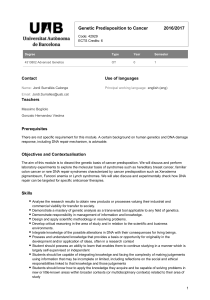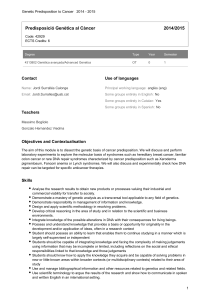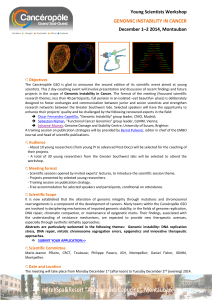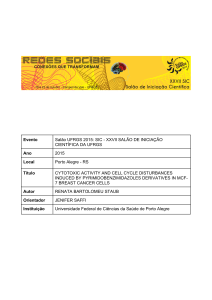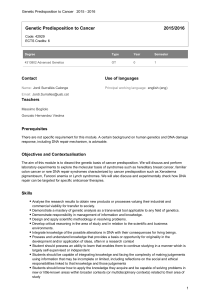Inhibition of DNA Topoisomerases II and/or I by a Activities KEN UMEMURA,
publicité
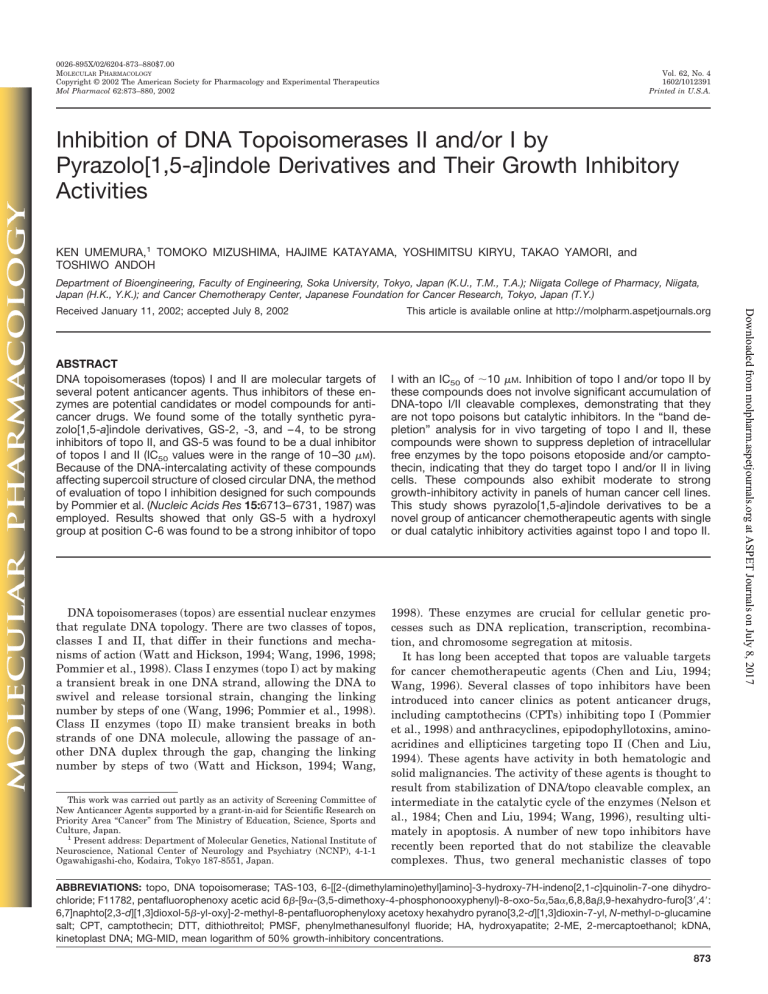
0026-895X/02/6204-873–880$7.00 MOLECULAR PHARMACOLOGY Copyright © 2002 The American Society for Pharmacology and Experimental Therapeutics Mol Pharmacol 62:873–880, 2002 Vol. 62, No. 4 1602/1012391 Printed in U.S.A. Inhibition of DNA Topoisomerases II and/or I by Pyrazolo[1,5-a]indole Derivatives and Their Growth Inhibitory Activities KEN UMEMURA,1 TOMOKO MIZUSHIMA, HAJIME KATAYAMA, YOSHIMITSU KIRYU, TAKAO YAMORI, and TOSHIWO ANDOH Department of Bioengineering, Faculty of Engineering, Soka University, Tokyo, Japan (K.U., T.M., T.A.); Niigata College of Pharmacy, Niigata, Japan (H.K., Y.K.); and Cancer Chemotherapy Center, Japanese Foundation for Cancer Research, Tokyo, Japan (T.Y.) ABSTRACT DNA topoisomerases (topos) I and II are molecular targets of several potent anticancer agents. Thus inhibitors of these enzymes are potential candidates or model compounds for anticancer drugs. We found some of the totally synthetic pyrazolo[1,5-a]indole derivatives, GS-2, -3, and – 4, to be strong inhibitors of topo II, and GS-5 was found to be a dual inhibitor of topos I and II (IC50 values were in the range of 10 –30 M). Because of the DNA-intercalating activity of these compounds affecting supercoil structure of closed circular DNA, the method of evaluation of topo I inhibition designed for such compounds by Pommier et al. (Nucleic Acids Res 15:6713– 6731, 1987) was employed. Results showed that only GS-5 with a hydroxyl group at position C-6 was found to be a strong inhibitor of topo DNA topoisomerases (topos) are essential nuclear enzymes that regulate DNA topology. There are two classes of topos, classes I and II, that differ in their functions and mechanisms of action (Watt and Hickson, 1994; Wang, 1996, 1998; Pommier et al., 1998). Class I enzymes (topo I) act by making a transient break in one DNA strand, allowing the DNA to swivel and release torsional strain, changing the linking number by steps of one (Wang, 1996; Pommier et al., 1998). Class II enzymes (topo II) make transient breaks in both strands of one DNA molecule, allowing the passage of another DNA duplex through the gap, changing the linking number by steps of two (Watt and Hickson, 1994; Wang, This work was carried out partly as an activity of Screening Committee of New Anticancer Agents supported by a grant-in-aid for Scientific Research on Priority Area “Cancer” from The Ministry of Education, Science, Sports and Culture, Japan. 1 Present address: Department of Molecular Genetics, National Institute of Neuroscience, National Center of Neurology and Psychiatry (NCNP), 4-1-1 Ogawahigashi-cho, Kodaira, Tokyo 187-8551, Japan. This article is available online at http://molpharm.aspetjournals.org I with an IC50 of ⬃10 M. Inhibition of topo I and/or topo II by these compounds does not involve significant accumulation of DNA-topo I/II cleavable complexes, demonstrating that they are not topo poisons but catalytic inhibitors. In the “band depletion” analysis for in vivo targeting of topo I and II, these compounds were shown to suppress depletion of intracellular free enzymes by the topo poisons etoposide and/or camptothecin, indicating that they do target topo I and/or II in living cells. These compounds also exhibit moderate to strong growth-inhibitory activity in panels of human cancer cell lines. This study shows pyrazolo[1,5-a]indole derivatives to be a novel group of anticancer chemotherapeutic agents with single or dual catalytic inhibitory activities against topo I and topo II. 1998). These enzymes are crucial for cellular genetic processes such as DNA replication, transcription, recombination, and chromosome segregation at mitosis. It has long been accepted that topos are valuable targets for cancer chemotherapeutic agents (Chen and Liu, 1994; Wang, 1996). Several classes of topo inhibitors have been introduced into cancer clinics as potent anticancer drugs, including camptothecins (CPTs) inhibiting topo I (Pommier et al., 1998) and anthracyclines, epipodophyllotoxins, aminoacridines and ellipticines targeting topo II (Chen and Liu, 1994). These agents have activity in both hematologic and solid malignancies. The activity of these agents is thought to result from stabilization of DNA/topo cleavable complex, an intermediate in the catalytic cycle of the enzymes (Nelson et al., 1984; Chen and Liu, 1994; Wang, 1996), resulting ultimately in apoptosis. A number of new topo inhibitors have recently been reported that do not stabilize the cleavable complexes. Thus, two general mechanistic classes of topo ABBREVIATIONS: topo, DNA topoisomerase; TAS-103, 6-[[2-(dimethylamino)ethyl]amino]-3-hydroxy-7H-indeno[2,1-c]quinolin-7-one dihydrochloride; F11782, pentafluorophenoxy acetic acid 6-[9␣-(3,5-dimethoxy-4-phosphonooxyphenyl)-8-oxo-5␣,5a␣,6,8,8a,9-hexahydro-furo[3⬘,4⬘: 6,7]naphto[2,3-d][1,3]dioxol-5-yl-oxy]-2-methyl-8-pentafluorophenyloxy acetoxy hexahydro pyrano[3,2-d][1,3]dioxin-7-yl, N-methyl-D-glucamine salt; CPT, camptothecin; DTT, dithiothreitol; PMSF, phenylmethanesulfonyl fluoride; HA, hydroxyapatite; 2-ME, 2-mercaptoethanol; kDNA, kinetoplast DNA; MG-MID, mean logarithm of 50% growth-inhibitory concentrations. 873 Downloaded from molpharm.aspetjournals.org at ASPET Journals on July 8, 2017 Received January 11, 2002; accepted July 8, 2002 874 Umemura et al. Materials and Methods Drugs and Chemicals. Among pyrazolo[1,5-a]indole derivatives used in this study (Fig. 1), GS-1, -2, and -3 were synthesized as described previously (Katayama et al., 1999, 2000). Preparation of the compounds with 6-oxygen substitution, GS-4 and -5, will be described elsewhere. VM-26 (teniposide) and VP-16 (etoposide) were provided by Bristol-Myers-Squib Co. (Brea, CA). Camptothecin was provided by Yakult Honsha Co. (Tokyo, Japan). Other chemicals were purchased from Wako Pure Chemical Industries Ltd. (Osaka, Japan). Cell Culture. H5 insect cells were grown in SF-900 II medium (Initrogen, Carlsbad, CA) supplemented with 10% fetal bovine serum at 27°C in a humidified atmosphere containing 5% CO2. Ehrlich ascites tumor cells were grown in Dulbecco’s modified Eagle’s medium supplemented with 10% fetal bovine serum and antibiotics (100 U/ml penicillin-G, 100 g/ml streptomycin sulfate). DLD-1 human colon carcinoma cells were grown in Dulbecco’s modified Eagle’s medium supplemented with 10% fetal bovine serum, minimal essential medium sodium pyruvate (Invitrogen), minimal essential medium amino acids (Invitrogen), and antibiotics. Preparation of Topoisomerases. Recombinant human topo II␣ was purified from a baculovirus expression system as follows. Recombinant baculovirus expressing human topo II␣ was a generous gift from Dr. H. Takahashi (National Institute of Infectious Diseases, Tokyo, Japan). In construction of the recombinant virus, the coding region of the human topo II␣ cDNA was first inserted into the transfer vector pVL1392 (BD PharMingen, San Diego, CA), followed by cotransfection with BaculoGold DNA (BD PharMingen) into H5 insect cells and selection of recombinant viruses. For preparation of recombinant topo II␣ protein, exponentially growing H5 cells were collected and the pelleted cells were infected with the recombinant virus by suspension in 2 volumes of culture supernatant of H5 cells infected with the virus. After incubation at room temperature for 1 h with periodic stirring, the cells were seeded at a density of ⬃1 ⫻ 106 cells per 100-mm dish and cultured at 27°C for 3 days. Cells were collected and suspended in 4 volumes of the lysis solution consisting of 5 mM phosphate buffer, pH 7.5, 1 mM MgCl2, 1 mM DTT, 0.1 mM EDTA, 0.05% Triton X-100, 1 mM PMSF, and 10 g/ml each of four protease inhibitors: trypsin inhibitor, leupeptin, aprotinin, and chymostatin. After incubation on ice for 20 min, crude nuclei were pelleted by centrifugation at 1000g, 4°C, for 5 min. The pellet was resuspended in 2 volumes of the lysis solution, and mixed with 2 volumes of the extraction solution consisting of 100 mM Tris-HCl, pH 7.5, 0.9 M NaCl, 1 mM DTT, 1 mM PMSF, and 10 g/ml each of the same four protease inhibitors as in lysis solution. After incubation on ice for 30 min, the sample was centrifuged at 10,000g, 4°C, for 15 min, and the supernatant was collected as nuclear extract. It was loaded onto a 1.0 ⫻ 6.4-cm hydroxyapatite column equilibrated with buffer HA consisting of 0.2 M potassium phosphate, pH 7.0, 10 mM 2-mercaptoethanol (2-ME), and 10% glycerol. After the column was washed with 20 ml of buffer HA, the sample was developed with a 40-ml linear gradient of 0.2 to 0.9 M potassium phosphate, pH 7.0, supplemented with 10 mM 2-ME and 10% glycerol, and the eluate was collected into 1 ml-fractions. Topo II activity of the fractions was assayed by kinetoplast DNA (kDNA) decatenation assay (see kDNA Decatenation Assay), and the positive fractions with salt concentrations of 0.36 to 0.41 M were pooled, and the salt concentration of the pool was brought to 0.2 M by 1.95-fold dilution with 10 mM 2-ME and 10% glycerol. The pool was then loaded onto a 0.9 ⫻ 3.0-cm heparin Sepharose CL-6B column (Pharmacia Fine Chemicals, Uppsala, Sweden) equilibrated with buffer HA, and the column was washed Fig. 1. Chemical structures of pyrazolo[1,5-a]indole derivatives investigated. TfO⫺, trifluoromethanesulfonate. Downloaded from molpharm.aspetjournals.org at ASPET Journals on July 8, 2017 inhibitors, especially for topo II, have recently been described (Andoh and Ishida, 1998): 1) classical topo “poisons” that stabilize the cleavable complexes and stimulate single- or double-stranded DNA cleavage, such as camptothecin and its derivatives, indolocarbazoles for topo I, and TAS-103 (Utsugi et al., 1997) for topos I and II, and (2) catalytic inhibitors that prevent catalytic cycle of the enzymes at steps other than cleavage intermediates, such as aclarubicin (Jensen et al., 1991), intoplicin (Riou et al., 1993), and F11782 (Perrin et al., 2000). Some of these compounds are dual inhibitors of topos I and II. Merbarone (Drake et al., 1989; Fortune and Osheroff, 1998) and dioxopiperazines are catalytic inhibitors of topo II (Ishida et al., 1991; Tanabe et al., 1991). Dioxopiperazines have been studied extensively and have been shown to inhibit the reopening of the closed clamp formed by the enzyme around the DNA by inhibiting ATPase activity of the enzyme, thus sequestering the enzyme within the cell (Roca et al., 1994; Andoh and Ishida, 1998). A series of pyrazolo[1,5-a]indole derivatives have been prepared in our laboratory in search for biologically active compounds. Some of the compounds exhibited biological activities, such as inhibition of topos and cytotoxicity against various tumor cells in vitro and in vivo (Katayama et al., 1999, 2000). In the present report, we further studied their structure-activity relationship by examining whether several new pyrazolo[1,5-a]indole derivatives interfere with topo I and II activity in vitro and whether they also target the enzymes in vivo. The results showed that: (1) four of five compounds examined are strong catalytic inhibitors of topo II and one is a dual inhibitor of topos I and II, (2) an interesting relationship of chemical structures and their activities against topos was found in vitro and in vivo, and (3) the four compounds that inhibit topo I or topo II have moderate or strong growth inhibitory activities against various human cancer cell lines. Pyrazolo[1,5-a]indoles as Topoisomerase I/II Inhibitors 15 min, drugs in the reaction mixtures were extracted with equal volume of chloroform and then with Tris/EDTA-saturated 1-butanol. The aqueous phases were mixed with 4 l of the dye/SDS stop solution, then analyzed by electrophoresis on 0.8% agarose gels without ethidium bromide. Topoisomerase I- and II-Mediated DNA Cleavage Assay. Topo I-mediated cleavable complex formation was carried out for pyrazolo[1,5-a]indole derivatives as described elsewhere (Hsiang et al., 1985; Yanase et al., 1999) with some modifications. Reaction mixtures (20 l) contained 50 mM Tris-HCl, pH 8.0, 50 mM NaCl, 0.5 mM EDTA, 0.5 mM DTT, 10% glycerol, 30 g/ml bovine serum albumin, 10 units of topo I, 0.2 g of supercoiled pT2GN plasmid DNA, and 1 l of a solution of pyrazolo[1,5-a]indole derivatives or camptothecin as a positive control. Reaction mixtures were incubated for 15 min at 37°C. In experiments of drug combination, 1 l each of a test compound and camptothecin were simultaneously added before the incubation, or the two compounds were sequentially added, one before the first incubation at 37°C for 15 min, followed by further 30-min incubation after the addition of the other, as denoted in the legend to Fig. 4. Then, 2.5 l of 10% SDS and 2 l of 20 mg/ml proteinase K were added and the reaction mixtures were digested at 37°C for 1 h. Proteins and drugs were removed by extraction with phenol/chloroform/isoamyl alcohol mixture (25:24:1). Aqueous phases were taken and mixed with 4 l of the dye/SDS stop solution and analyzed by electrophoresis on 0.6% agarose gels in the presence of 0.1 g/ml of ethidium bromide. Topo II-mediated DNA cleavage assay was carried out as described for topo I, with the following changes: reaction mixture contained in addition 10 mM MgCl2, 1 mM ATP, 4 units of recombinant human topo II in place of topo I, and VM-26 in place of camptothecin. Band Depletion Assays for Topo I and II. To quantify DNAtopo cleavable complexes in the cells treated with drugs, the “banddepletion assay” was employed according to the previous reports (Hsiang and Liu, 1988; Kaufmann and Svingen, 1999). DLD-1 cells (2.5 ⫻ 106) were plated in 100-mm dishes with 6 ml of the medium and cultured overnight. Solutions of pyrazoloindole derivatives (1 ml) in 7-fold higher than desired final concentrations prepared in culture medium were added to the medium of the cells and incubated for 30 min at 37°C. Similarly prepared relevant topo poisons (1 ml each; camptothecin for topo I assay and etoposide for topo II assay) in 8-fold concentrations in the medium was added to the medium of the cells followed by incubation for 30 min. Final concentration of the solvent dimethyl sulfoxide for the drugs in the culture was 0.6%. After incubation, cells were harvested by trypsinization and suspended in a 20 l of phosphate-buffered saline spiked with the same concentration of the topo inhibitors as was added to the culture medium for avoidance of rapid dissolution of the cleavable complexes Fig. 2. Inhibition of topo II by pyrazolo[1,5-a]indole derivatives. Decatenation of kDNA by topo II was performed, as described under Materials and Methods, in the absence (“no drug”) or in the presence of the test compounds indicated (the concentrations are represented in micromolar). Reaction was stopped by addition of stop solution containing SDS and the product was analyzed by electrophoresis on 0.8% agarose gels. “no enzyme”, no enzyme added. Downloaded from molpharm.aspetjournals.org at ASPET Journals on July 8, 2017 with 4 ml of the same buffer. The sample was eluted with 4 ml of the elution buffer consisting of 10 mM Tris-HCl, pH 7.5, 0.7 M NaCl, 0.5 mM EDTA, 1 mM DTT, 0.2 mM PMSF, and 10% glycerol, and the eluate was collected into 0.2-ml fractions. Topo II activity of the fractions was assayed by kDNA decatenation assay. The positive fractions were pooled and mixed with 0.8 volumes of glycerol to make the final concentration of 50%. This final pool was checked by topo II-mediated DNA cleavage assay (see Topoisomerase I- and II-Mediated DNA Cleavage Assay) for absence of ATP-independent DNAnicking activity. Isolation of mouse topo I from Ehrlich ascites tumor cells was carried out essentially as described above for human topo II␣ and as described previously (Ishii et al., 1983), except that the NaCl concentration for extraction of the enzyme from crude nuclei was 0.35 M and the hydroxyapatite column chromatography was skipped. Topo I activity of the fractions from heparin Sepharose column was monitored by conventional DNA relaxation assay (Ishii et al., 1983; Yanase et al., 1999). Substrate DNAs for Assays of Topoisomerases. kDNA for the decatenation assay of topo II was isolated from protozoa Crithidia fasciculata culture as described previously (Simpson and Simpson, 1974; Shapiro et al., 1999) with some modifications. Relaxed form Ir DNA for the assay of inhibitory activity of DNA-intercalating agents against topo I was prepared by incubation of supercoiled form I pT2GN plasmid DNA with sufficient amount of mouse topo I, followed by purification through SDS-proteinase K digestion, phenol extraction, and ethanol precipitation. kDNA Decatenation Assay. Inhibitory activity of test compounds on topo II activity was evaluated by detecting the conversion of catenated kDNA to monomer minicircles as described previously (Sato et al., 2000). One unit of the enzyme was defined as the minimal amount of activity required to decatenate 0.2 g of catenated kDNA. Analysis of Topo I Inhibition by DNA-Intercalating Pyrazolo[1,5-a]indole Derivatives. Activity of topo I and its inhibition was assayed essentially as described previously (Ishii et al., 1983; Yanase et al., 1999; Sato et al., 2000; Stewart and Champoux, 2001). Inhibition of topo I by DNA-intercalating agents, such as pyrazolo[1,5-a]indole derivatives, was analyzed in principle according to Pommier et al. (1987) as follows. The 20-l reaction mixture contained 50 mM Tris-HCl, pH 8.0, 50 mM NaCl, 0.5 mM EDTA, 0.5 mM DTT, 10% glycerol, 30 g/ml bovine serum albumin, 1 l of test compounds in dimethyl sulfoxide, 1 unit of topo I, and 0.2 g each of the supercoiled pT2GN plasmid DNA or the relaxed form I DNA of the same plasmid. One unit of the enzyme was defined as the minimal amount of activity required to relax 0.2 g of supercoiled pT2GN DNA under the conditions used. After incubation at 37°C for 875 876 Umemura et al. TABLE 1 Activities of pyrazolo[1,5-a]indole derivatives Inhibition of Topo I MG-MIDa Inhibition of Topo II Compound IC50 CC IC50 N.T. N.T. N.T. N.T. ⫺ ⫹ ⫺ ⫺ 300⬍ 30 20 10 20 300⬍ 10 5 M GS-1 GS-2 GS-3 GS-4 GS-5 CPT VP-16 ICRF-193 100⬍ 100⬍ 100⬍ 100⬍ ⬃10 3 300⬍ 300⬍ CC by JFCR N.T. ⫺ ⫺ ⫹/⫺ ⫺ ⫺ ⫹ ⫺ ⫺4.12 ⫺6.45 ⫺4.96 N.T. N.T. ⫺7.0 ⫺5.2 ⫺5.9 M b by NCIc M N.T. N.T. N.T. ⫺6.43 ⫺5.91 ⫺7.3 ⫺4.9 N.T. CC, cleavable complex; N.T., not tested; ⫹, involvement of stabilization of relevant topo-DNA cleavable complex; ⫺, no stabilization a Mean logarithm of 50% growth-inhibitory concentrations in a human cancer cell line panel. b Determined by human cancer cell line panel of Cancer Chemotherapy Center, Japanese Foundation for Cancer Research (39 cell lines). c Determined by human cancer cell line panel of National Cancer Institute, National Institutes of Health (47 cell lines). Results Pyrazolo[1,5-a]indole Derivatives Inhibit DNA Topo I and/or II in Vitro. We tested pyrazolo[1,5-a]indole derivatives, shown in Fig. 1, for inhibition of topo II activity by kDNA decatenation assay. As shown in Fig. 2, all compounds except GS-1 strongly inhibited topo II activity, with approximate IC50 values of 30 M for GS-2, 20 M for GS-3 and GS-5, and 10 M for GS-4 (Table 1). Because these compounds are DNA intercalators of various potency, as shown in Fig. 3, some compete with ethidium bromide for DNA on the gels, giving weak DNA bands [e.g., GS-2 (Fig. 2)]. Smeary bands overlapping the position of monomeric DNA in lanes for 100 M GS-3 are caused by fluorescence of the residual GS-3 compound. Next, we tested these compounds for inhibition of topo I activity by conventional assay monitoring relaxation of supercoiled plasmid DNA. However, the results were confused by distortion of the supercoil structure of DNA by intercalating activity of the compounds (data not shown). Therefore, we used an alternative method reported by Pommier et al. (1987), enabling us to test topo I inhibition by DNA intercalating agents. In this method, relaxed circular FIr DNA is used as a substrate, and the relaxing activity of topo I is measured on the substrate DNA to which supercoil is introduced by an intercalating agent to be tested. Thus, when the agent does not inhibit the enzyme, the supercoil introduced by the agent is relaxed, so that the linking number of DNA is reduced, resulting in reproduction of negative supercoils on extraction of the test compound from the DNA. In contrast, when the intercalating agent inhibits the enzyme, the substrate FIr DNA remains as it is. Thus, formation of supercoiled FI DNA in the reaction using FIr DNA as a substrate indicates that the test compound does not fully inhibit topo I activity; the absence of FI DNA indicates either that the test compound fully inhibited the enzyme or that the compound does not sufficiently intercalate into DNA under the conditions used. Figure 3 shows results for GS-2 and GS-5. In Fig. 3A, where supercoiled FI DNA is used as a substrate, GS-2 at ⱖ30 M, GS-5 at ⱖ10 M, and ethidium bromide at 2 g/ml seemed to inhibit relaxation of supercoiled FI DNA. However, when relaxed FIr DNA was used as a substrate (Fig. 3B), ethidium bromide at 2 g/ml and GS-2 at 100 M were found not to inhibit topo I, as evidenced by the presence of the band for FI DNA, whereas GS-5 inhibited the enzyme activity with an IC50 of ⬃10 M, as evidenced by the diminished band for FI DNA. No inhibition of the enzyme was observed with GS-1, GS-3, and GS-4 at 100 M, respectively (data not shown). The results are summarized in Table 1. Thus, GS-5 was shown to be unique in that it inhibits both topo II and topo I. Inhibition of Topos by Pyrazolo[1,5-a]indole Derivatives Does Not Involve Significant Accumulation of DNA Strand Breaks. DNA topoisomerase inhibitors are classified according to whether they induce accumulation of topo-dependent DNA strand breaks as “cleavable complexes” or not, reflecting the mechanism of inhibition. We examined whether GS-4 inhibiting topo II only and GS-5 inhibiting both topo I and topo II induced accumulation of cleavable complexes. The reaction by topo I or II in the presence of the test compound was stopped by addition of 1% SDS and digested with proteinase K to convert the cleavable complexes into nicked or linear forms of DNA, which were then separated by electrophoresis on agarose gels containing ethidium bromide. For clarity, the same samples from the reactions in Fig. 4A, as denoted, were electrophoresed with reduced sample load and elongated time of electrophoresis to improve resolution (Fig. 4B). In inhibition tests of topo II, either GS-4 Downloaded from molpharm.aspetjournals.org at ASPET Journals on July 8, 2017 within the cells. Equal volume of 2⫻ loading buffer consisting of 125 mM Tris-HCl, pH 6.8, 4% SDS, 1.4 M 2-ME, 20% glycerol, and 0.004% bromphenol blue was added and immediately sonicated to diminish viscosity (sonifier 450; Branson Ultrasonics, Corp., Danbury, CT) while chilling on ice. The samples were separated by SDS-polyacrylamide gel electrophoresis on 7.5% polyacrylamide gels and blotted to a polyvinylidene fluoride membrane, Immobilon P (Millipore, Bedford, MA). The blot was blocked with 5% skim milk/phosphatebuffered saline, reacted with relevant primary antibody (anti-human topo I monoclonal antibody T14C (Sugimoto et al., 1990), which was a generous gift from Dr. Y. Sugimoto (Cancer Chemotherapy Center, Japanese Foundation for Cancer Research, Tokyo, Japan), or antihuman topo II monoclonal antibody 2H5 prepared by Medical and Biological Laboratories, Ltd. (Nagoya, Japan), then with the secondary antibody, peroxidase-conjugated anti-mouse IgG (Amersham Biosciences, Piscataway, NJ). The signal was visualized using the ECL plus Kit (Amersham Biosciences). Human Cancer Cell Line Panel Analysis. The growth-inhibitory activities of pyrazolo[1,5-a]indole derivatives were evaluated using human cancer cell line panels consisting of 39 or 47 cancer cell lines, as specified in Table 1, established, respectively, in Cancer Chemotherapy Center, Japanese Foundation for Cancer Research, Tokyo, Japan (Yamori et al., 1999; Katayama et al., 2000) and in National Cancer Institute, National Institutes of Health, Bethesda, MD (Monks et al., 1991; Katayama et al., 2000). Pyrazolo[1,5-a]indoles as Topoisomerase I/II Inhibitors 877 or GS-5 showed no accumulation of cleavable complexes, as revealed by no accumulation of the nicked circular form FII and the linear form FIII DNA (Fig. 4A, compare with VM-26): the sums of the band intensities for FII and FIII DNA corresponding to the amount of cleavable complexes in the lanes for the reactions containing GS-4 or GS-5 alone (23 and 28% of that for 30 M VM-26, respectively) is even lower than that for the reaction with enzyme only (no drug, 41%). With 300 M GS-4, a faint FIII band appears, but this band is also present in “no drug”. When GS-4 was added simultaneously with a topo II poison, VM-26, accumulation of the complexes was significantly inhibited, as evidenced by decrease in the amount of FII and FIII DNA (45% of that with 30 M VM-26 alone) and concurrent increase of the FIr DNA with an altered mobility due to intercalation of GS-4 into DNA, represented as “FIr” (Fig. 4B). When GS-4 was added after addition of VM-26 (i.e., after accumulation of the complexes in the presence of VM-26), they decreased in amount (48%), resulting in a similar pattern of bands obtained by simultaneous addition, indicating that GS-4 is capable of reversing topo II-DNA cleavable complexes that have been already accumulated by VM-26. In contrast, this effect was apparently not observed with GS-5; whereas GS-5 added simultaneously with VM-26 completely inhibited the accumulation of cleavable complexes (35%, similar to that for “no drug”), GS-5 added after the formation of cleavable complexes resulted in only a modest reversion of the reaction (79%). These observations show that although GS-4 and GS-5 are both topo II catalytic inhibitors, these compounds are somewhat different in the mode of action on topo II reaction. Next, we investigated whether GS-5, the only compound having dual activity against topos I and II, induced druginduced and topo I-mediated accumulation of cleavable complexes. As shown in Fig. 4C, CPT, a typical topo I poison, induced accumulation of cleavable complexes as indicated by accumulation of nicked circular form II DNA, whereas GS-5 at 300 M (and at lower concentrations of 10 and 30 M also, data not shown) barely induced accumulation of the complex (27% of that for 5 M CPT), indicating that it is not a poison but a catalytic inhibitor of topo I. It is of great interest to note that GS-5 completely inhibited CPT from inducing accumulation of cleavable complexes when added simultaneously (23%), and that it further elicited partial reversion of the cleavable complex already formed in the presence of CPT (63%), as illustrated in Fig. 4C (lane CPT53GS-5 300). GS-4 and GS-5 Target Topo II and/or Topo I in Cultured Cells. To test whether GS-4 and GS-5 act on topo II and topo I, not only in vitro but also in living cells, we carried out “band depletion” analysis for topo II and topo I, as described under Materials and Methods, which detects free enzymes left within the cells not covalently bound to cellular DNA. Treatment of DLD-1 human colon carcinoma cells with the topo poisons VP-16 or CPT caused depletion of free enzymes, topo II or topo I, detectable by Western blotting, suggesting accumulation of topo II- or topo I-mediated cleavable complexes within the cells, respectively (Fig. 5, A and B). Pretreatment of the cells with 150 M GS-4 or GS-5 before 200 M VP-16 treatment restored free topo II enzyme to near original levels (Fig. 5A). Similarly, pretreatment of cells with 150 M GS-5 before 50 M CPT treatment resulted in restoration of free topo I to near original levels (Fig. 5B). These observations clearly indicate that GS-4 and GS-5 in fact Downloaded from molpharm.aspetjournals.org at ASPET Journals on July 8, 2017 Fig. 3. Inhibition of topo I by pyrazolo[1,5-a]indole derivatives. Reaction mixtures containing substrate DNAs and topo I were incubated in the presence of test compounds as described under Materials and Methods. Supercoiled form I (A) or relaxed form Ir (B) circular DNAs were used as substrates. After reaction enzyme and test compounds were inactivated and removed by shaking with phenol/chloroform/isoamyl alcohol, and the reaction products were electrophoresed on 0.8% agarose gels. No topo I was used in reactions in the lanes marked “no enzyme”, no test compounds were included in reactions in lanes marked “no drug”, and the indicated compounds (the concentrations are represented in micromolar) were included in reactions for the rest. FI, supercoiled circular form I DNA; FIr, relaxed circular form Ir DNA. 878 Umemura et al. targeted topo I and/or topo II as catalytic inhibitors within the cells, sequestering the enzymes from being incorporated into the cleavable complexes by topo poisons. Pyrazolo[1,5-a]indole Derivatives Inhibit Growth of Human Cancer Cell Lines. Growth-inhibitory activity of the pyrazolo[1,5-a]indole derivatives was investigated on human cancer cell line panels, which consist of 39 lines (GS-1, -2 and -3 on the panel of Cancer Chemotherapy Center of Japanese Foundation for Cancer Research) or of 47 lines (GS-4 and -5 on the panel of the National Cancer Institute). GS-1 showed poor inhibitory activity, GS-3 showed moderate inhibitory activity, and GS-2, -4, and -5 showed strong inhibitory activities (Table 1) compared with the standard topo inhibitors CPT (topo I poison, MG-MID being ⫺7.0 ⬃ ⫺7.3), VP-16 (topo II poison, MG-MID being ⫺5.2 ⬃ ⫺4.9), or ICRF193 (topo II catalytic inhibitor, MG-MID being ⫺5.9). Discussion We have shown in the present report that some novel pyrazolo[1,5-a]indole derivatives that were totally synthesized recently (Katayama et al., 1999, 2000) are inhibitors of topo I and/or topo II, as shown in in vitro studies; furthermore, they target these enzymes in living cells as well and exert growth inhibitory effect on human cancer cells. Most of the topo inhibitors used as anticancer drugs in clinics are of topo poison-type and are natural or semisynthetic compounds. In contrast, pyrazolo[1,5-a]indole derivatives are toFig. 5. Band depletion analysis of topo II and topo I in DLD-1 human colon carcinoma cells. Cells were exposed to drugs singly or in combination, as described under Materials and Methods. One hour after incubation, cells were collected by trypsinization and lysed by addition of SDS-containing lysis buffer. After protein determination, immunoblotting was performed. A, Western blotting (top) and Coomassie Brilliant Blue staining (bottom) for topo II of the crude extract of the cells exposed to the drugs as indicated at concentrations in micromolar. B, Western blotting (top) and Coomassie Brilliant Blue staining (bottom) for topo I of the crude extract of the cells exposed to the drugs as indicated. Each paired lane represents a pair of duplicate cell cultures. Downloaded from molpharm.aspetjournals.org at ASPET Journals on July 8, 2017 Fig. 4. Inhibition by pyrazolo[1,5-a]indole derivatives of topo II- or topo I-mediated DNA cleavage induced by VM-26 or CPT, respectively. Reaction mixtures containing FI plasmid DNA as substrate, 4 units of topo II␣ (A and B), or 10 units of topo I (C) were incubated in the presence of test compounds as described under Materials and Methods. After incubation, reaction mixtures were digested with proteinase K/SDS and cleavable complexes in the reaction mixtures were converted to linear or nicked circular DNAs. The products were electrophoresed on 0.6% agarose gels in the presence of 0.1 g/ml ethidium bromide enabling a good resolution of four forms of DNA: supercoiled form FI, relaxed circular form FIr (with no nicks), nicked circular form FII, and linear form FIII. A, topo II-mediated DNA cleavage. No enzyme was included in the reaction for “no enzyme”, and no test compounds were added to reaction for “no drug”. The indicated compounds (the concentrations are represented in micromolar) were included in the reactions as test compounds. The symbol “⫹” illustrates simultaneous administration of the two compounds, and the arrows indicate sequential addition, as described under Materials and Methods. Note that the mobility of form Ir DNA for the reaction with GS-4 only is different from that for the reactions containing GS-4 and VM-26. B, the same samples from the reactions in A were electrophoresed with reduced sample load and elongated time of electrophoresis to improve resolution. C, topo I-mediated DNA cleavage. FI, supercoiled circular form I DNA; FIr, relaxed circular form Ir DNA; Fir⬘, relaxed circular form Ir DNA with altered mobility by intercalation of GS-4; FII, nicked circular form II DNA; FIII, linear form III DNA. Under the photographs are indicated the band densities of FII plus FIII (A and B) or FII (C) DNA; the percentage of those for VM-26 30 M (A and B) or CPT 5 M (C) is taken as 100%. Pyrazolo[1,5-a]indoles as Topoisomerase I/II Inhibitors 26-induced cleavable complexes and shifts the equilibrium toward a quaternary complex (topo II/DNA/VM-26/GS-4) with a different supercoil structure from that formed in the presence of GS-4 alone. Present experiments revealed that GS-5 is a dual catalytic inhibitor of topo I and topo II: 1) it does not stabilize cleavable complexes with either topo I or topo II; 2) it interferes with induction of cleavable complex stabilization by VM-26 and CPT; and 3) it does not affect equilibration of preformed cleavable complexes stabilized by VM-26, but slightly reverses the cleavable complexes stabilized by CPT. These unique properties of GS-4 and GS-5 with characteristic mode of inhibition of topos I and II were verified in living cells (Fig. 5): GS-4 was shown to target topo II and to interfere with VP-16 from stabilization of cleavable complexes, whereas GS-5 targeted topos I and II and interfered with both VP-16 and CPT from stabilization of the complexes in vivo. In recent years, more than a dozen catalytic inhibitors of topo II have been reported, and some of them were characterized with respect to anticancer activities, such as escape from drug resistance against topo II poisons, competitive or supra-additive effects with topo II poisons in vivo, and with respect to molecular mechanism of action, such as inhibition of enzymes from binding to DNA (aclarubicin, etc.), stabilization of postcleavage complex (bisdioxopiperazines) (Roca et al., 1994; Andoh and Ishida, 1998). In this regard, the antitumor characteristics of the pyrazolo[1,5-a]indole derivatives, which have novel chemical structures, are of great interest. In addition, GS-5 was also shown to be a dual catalytic inhibitor of topos I and II, one of the rare examples of dual inhibitors such as aclarubicin (Sorensen et al., 1994; Sehested and Jensen, 1996), intoplicine (Riou et al., 1993), TAS-103 (Utsugi et al., 1997), and F11782 (Perrin et al., 2000). The mechanism of action of these novel synthetic antitumor agents awaits further investigation. The compounds GS-1 through GS-5 were examined for growth inhibitory activity on human cancer cell line panels. GS-2, -3, -4, and -5 were shown to have moderate to strong cytotoxic activity on various cancer cell lines comparable with those of reference topo inhibitors such as camptothecin, etoposide, and ICRF-193 (Table 1). These results, together with the finding that the drugs target the enzymes in living cells (Fig. 5), suggest that the cytotoxicity results from inhibition of these enzymes in living cells, although the evidence provided in this report is not direct. Further investigation using topo I/II-defective cells would lead to a definitive conclusion. In any case, pyrazoloindols and their derivatives with novel structure are hopeful candidates for anticancer drugs. Acknowledgments We are grateful to the Developmental Therapeutics Program of the National Cancer Institute (Bethesda, MD) for providing data from human cancer cell line panel analysis of GS-4 and GS-5. References Andoh T and Ishida R (1998) Catalytic inhibitors of DNA topoisomerase II. Biochim Biophys Acta 1400:155–171. Chen AY and Liu LF (1994) DNA topoisomerases: essential enzymes and lethal targets. Annu Rev Pharmacol Toxicol 34:191–218. Drake FH, Hofmann GA, Mong SM, Bartus JO, Hertzberg RP, Johnson RK, Mattern MR, and Mirabelli CK (1989) In vitro and intracellular inhibition of topoisomerase II by the antitumor agent Merbarone. Cancer Res 49:2578 –2583. Fortune JM and Osheroff N (1998) Merbarone inhibits the catalytic activity of human topoisomerase II␣ by blocking DNA cleavage. J Biol Chem 273:17643– 17650. Downloaded from molpharm.aspetjournals.org at ASPET Journals on July 8, 2017 tally synthetic compounds and were found to be catalytic inhibitors, as shown in the present article. They are strongly cytotoxic against a wide variety of cancer cell lines in vitro and hence will make a novel chemical source for topo-inhibiting anticancer drugs. In kDNA decatenation assay, GS-2 through GS-5 were shown to be potent inhibitors of topo II but GS-1 lacked this activity. GS-2 through GS-5 were also shown to inhibit the growth of various human cancer cell lines. The COMPARE software (Yamori et al., 1999) indicated no compounds with similar inhibition spectrum to GS-2 and -3 (data not shown), suggesting a unique mode of action of pyrazolo[1,5-a]indole derivatives on cancer cells. In contrast, GS-1 was more than 10 times weaker than other derivatives in inhibitory activity on cancer cells (Table 1). This compound is less soluble in water than other compounds because it is a tertiary amine, whereas others are quaternary amines, such as methyl triflate salts, and hence soluble in water. This might be the reason for its ineffectiveness. GS-5 is unique in that it is a dual inhibitor targeting topos I and II. In Fig. 3B, a strong intercalator ethidium bromide was shown not to be a topo I inhibitor, because the substrate relaxed FIr DNA was converted to supercoiled FI DNA. This conclusion could be explained as follows: 1) the substrate FIr DNA gets positively supercoiled by intercalation of ethidium bromide, 2) followed by relaxation by topo I, reducing linking number of the DNA, because the enzyme is not inhibited by ethidium bromide, and finally 3) substrate DNA becomes negatively supercoiled (FI) on removal of intercalated ethidium bromide. Similarly 100 M of GS-2 brought about formation of similar amount of FI DNA, indicating that GS-2 scarcely inhibited topo I at 100 M. As for GS-3 and -4, the results were similar to that of GS-2 (data not shown). On the other hand, GS-5 gave the maximum amount of FI DNA at 10 M, but that amount was nearly half that formed by ethidium bromide or GS-2, indicating that the IC50 of GS-5 is ⬃10 M. The absence of the band for FI DNA in the lanes for a lower concentration of 3 M GS-5 in Fig. 3B is attributable to insufficient intercalation of GS-5 into DNA at this concentration, supported by the fact that the mobility of the supercoiled DNA in the lanes for 3 M GS-5 in Fig. 3A is different from those in the lanes for 10 or 30 M. The finding that GS-5, but not GS-4, inhibits topo I is surprising, because there is only a subtle difference between GS-5 and GS-4 in chemical structure at C-6 position, where GS-5 has a hydroxyl group and GS-4 a methoxy group. GS-5 may have higher affinity for topo I and inhibit the enzyme from access to DNA. The molecular mechanism whereby only GS-5 but not GS-4 inhibits topo I needs to be formally addressed. Caution should be exercised in interpreting the results of in vitro DNA cleavage assays shown in Fig. 4, A and B, in which the bands of relaxed circular form Ir DNA are shifted upward when the reaction mixtures contained both GS-4 and VM-26 (FIr⬘ in Fig. 4, A and B; compare with the reactions containing VM-26 only). This observation may be explained as follows: relaxation reaction of DNA in the presence of intercalated GS-4 resulted in a relaxed form I with a different final supercoil density with fewer linking numbers after extraction of the drug. In addition, when the reaction mixture contained GS-4 alone, the mobility of the band of FIr DNA was different from that in the presence of both GS-4 and VM-26. This suggests that GS-4 interacts with the VM- 879 880 Umemura et al. opiperazines inhibit yeast DNA topoisomerase II by trapping the enzyme in the form of a closed protein clamp. Proc Natl Acad Sci USA 91:1781–1785. Sato S, Fukuda Y, Nakagawa R, Tsuji T, Umemura K, and Andoh T (2000) Inhibition of DNA topoisomerases by nidulalin A derivatives. Biol Pharm Bull 23:511–512. Sehested M and Jensen PB (1996) Mapping of DNA topoisomerase II poisons (etoposide, clerocidin) and catalytic inhibitors (aclarubicin, ICRF-187) to four distinct steps in the topoisomerase II catalytic cycle. Biochem Pharmacol 51:879 – 886. Shapiro TA, Klein VA, and Englund PT (1999) Isolation of kinetoplast DNA, in Methods in Molecular Biology, Vol. 94: DNA Topoisomerase Protocols, Part I: DNA Topology and Enzymes (Bjornsti M-A and Osheroff N eds) pp 61– 67, Humana Press, Clifton, New Jersey. Simpson AM and Simpson L (1974) Isolation and characterization of kinetoplast DNA networks and minicircles from Crithidia fasciculata. J Protozool 21:774 –781. Sorensen BS, Jensen PB, Sehested M, Jensen PS, Kjeldsen E, Nielsen OF, and Alsner J (1994) Antagonistic effect of aclarubicin on camptothecin induced cytotoxicity: role of topoisomerase I. Biochem Pharmacol 47:2105–2110. Stewart L and Champoux JJ (2001) Assaying DNA topoisomerase I relaxation activity, in Methods in Molecular Biology, Vol. 94: DNA Topoisomerase Protocols, Part II: Enzymology and Drugs (Bjornsti M-A and Osheroff N eds) pp 1–11, Humana Press, Clifton, New Jersey. Sugimoto Y, Tsukahara S, Oh-hara T, Isoe T and Tsuruo T (1990) Decreased expression of DNA topoisomerase I in camptothecin-resistant tumor cell lines as determined by a monoclonal antibody. Cancer Res 50:6925– 6930. Tanabe K, Ikegami Y, Ishida R, and Andoh T (1991) Inhibition of topoisomerase II by antitumor agents bis(2,6-dioxopiperazine) derivatives. Cancer Res 51:4903– 4908. Utsugi T, Aoyagi K, Asao T, Okasaki Y, Aoyagi Y, Sano M, Wierzba K, and Yamada Y (1997) Antitumour activity of a novel quinolone derivative, TAS-103, with inhibitory effects on topoisomerases I and II. Jpn J Cancer Res 88:992–1002. Wang JC (1996) DNA topoisomerases. Annu Rev Biochem 65:635– 692. Wang JC (1998) Moving one DNA double helix through another by a type II DNA topoisomerase: the story of a simple molecular machine. Q Rev Biophys 31:107– 144. Watt PM and Hickson ID (1994) Structure and function of type II DNA topoisomerases. Biochem J 303:681– 695. Yamori T, Matsunaga A, Sato S, Yamazaki K, Komi A, Ishizu K, Mita I, Edatsugi H, Matsuba Y, Takezawa K, et al. (1999) Potent antitumor activity of MS-247, a novel DNA minor groove binder, evaluated by an in vitro and in vivo human cancer cell line panel. Cancer Res 59:4042– 4049. Yanase K, Sugimoto Y, Andoh T, and Tsuruo T (1999) Retroviral expression of a mutant (Gly-533) human DNA topoisomerase I cDNA confers a dominant form of camptothecin resistance. Int J Cancer 81:134 –140. Address correspondence to: Toshiwo Andoh, Soka University, Faculty of Engineering, Department of Bioengineering, 1-236 Tangi-machi, Hachiouji, Tokyo 192-8577, Japan. E-mail: [email protected] Downloaded from molpharm.aspetjournals.org at ASPET Journals on July 8, 2017 Hsiang Y-H, Hertzberg R, Hecht S, and Liu LF (1985) Camptothecin induces proteinlinked DNA breaks via mammalian DNA topoisomerase I. J Biol Chem 260: 14873–14878. Hsiang Y-H and Liu LF (1988) Identification of mammarian DNA topoisomerase I as an intracellular target of the anticancer drug camptothecin. Cancer Res 48:1722– 1726. Ishida R, Miki T, Narita T, Yui R, Sato M, Utsugi KR and Andoh T (1991) Inhibition of intracellular topoisomerase II by antitumor bis(2,6-dioxopiperazine) derivatives: mode of cell growth inhibition distinct from that of cleavable complexforming type inhibitors. Cancer Res 51:4909 – 4916. Ishii K, Hasegawa T, Fujisawa K, and Andoh T (1983) Rapid purification and characterization of DNA topoisomerase I from cultured mouse mammary carcinoma FM3A cells. J Biol Chem 258:12728 –12732. Jensen PB, Jensen PS, Demant EJ, Friche E, Sorensen BS, Sehested M, Wassermann K, Vindelov L, Westergaard O and Hansen HH (1991) Antagonistic effect of aclarubicin on daunorubicin-induced cytotoxicity in human small cell lung cancer cells: relationship to DNA integrity and topoisomerase II. Cancer Res 51:5093– 5099. Katayama H, Kawada Y, Kaneko K, Oshiyama T, and Takatsu N (1999) Synthetic inhibitors of DNA topoisomerase I and II. Chem Pharm Bull 47:48 –53. Katayama H, Kiryu Y, Kaneko K, and Ohshima R (2000) Anti-cancer activities of pyrazolo[1,5-a]indole derivatives. Chem Pharm Bull 48:1628 –1633. Kaufmann SH and Svingen PA (1999) Immunoblot analysis and band depletion assays, in Methods in Molecular Biology, Vol. 94: DNA Topoisomerase Protocols, Part I: DNA Topology and Enzymes (Bjornsti M-A and Osheroff N eds) pp 253–268, Humana Press, Clifton, New Jersey. Monks A, Scudiero D, Skehan P, Shoemaker R, Paull K, Vistica D, Hose C, Langley J, Cronise P, Vaigro-Wolff A, et al. (1991) Feasibility of a high-flux anticancer drug screen using a diverse panel of cultured human tumor cell lines. J Natl Cancer Inst 83:757–766. Nelson EM, Tewey KM, and Liu LF (1984) Mechanism of antitumor drug action: poisoning of mammalian DNA topoisomerase II on DNA by m-AMSA. Proc Natl Acad Sci USA 81:1361–1365. Perrin D, van Hille B, Barret JM, Kruczynski A, Etievant C, Imbert T, and Hill BT (2000) F11782, a novel non-intercalating dual inhibitor of topoisomerases I and II with an original mechanism of action. Biochem Pharmacol 59:807– 819. Pommier Y, Covey JM, Kerrigan D, Markovits J, and Pham R (1987) DNA unwinding and inhibition of mouse leukemia L1210 DNA topoisomerase I by intercalators. Nucleic Acids Res 15:6713– 6731. Pommier Y, Pourquier P, Fan Y, and Strumberg D (1998) Mechanism of action of eukaryotic DNA topoisomerase I and drugs targeted to the enzymes. Biochim Biophys Acta 1400:83–105. Riou JF, Fosse P, Nguyen CH, Larsen AK, Bissery MC, Grondard L, Saucier JM, Bisagni E, and Lavelle F (1993) Intoplicine (RP 60475) and its derivatives, a new class of antitumour agents inhibiting both topoisomerase I and II activities. Cancer Res 53:5987–5993. Roca J, Ishida R, Berger JM, Andoh T, and Wang JC (1994) Antitumor bisdiox-



